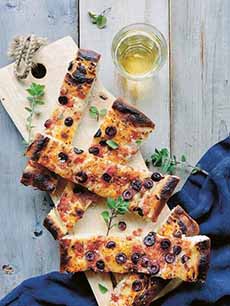Pizza Vs. Flatbread For National Pizza Party Day
|
May 20th is National Pizza Party Day (it varies yearly: the third Friday of May). Can you make a flatbread instead? Sure, we say: because pizza vs. flatbread is simply a matter of the dough. The main technical difference between flatbread and pizza is that: Even though purists make a different dough for each, according to Basta Pasta, “many chain restaurants and even small local Italian restaurants use the same exact dough for flatbreads and pizzas.” The difference is they don’t allow the flatbread dough the time to rise. Wbile you can buy it in most markets, here’s a recipe to make flatbread dough from scratch. And if you want to start a food holiday trend: There is currently no National Flatbread Day. Yes: the same cheeses, sauces, vegetables, and proteins can be used on both pizza and flatbread. > The history of flatbread is below. > Make your own pita-like flatbread in a skillet. Flatbreads were among the earliest processed foods, i.e., a product created from different ingredients that are combined such that, to paraphrase Aristotle, the whole is different than than the sum of its parts. Flatbread is unleavened bread. It is made without yeast and thus does not rise (i.e., it remains flat). Flour, water, and salt are the main ingredients. The flour does not need to be wheat or other cereal. It can be made with pseudocereals or legumes. The dough is rolled out flat and baked. The result is always relatively thin, ranging from a few millimeters to a few centimeters in thickness. Evidence of flatbread has been found at ancient sites in Egypt, the Indus Valley, and Mesopotamia. Charred flatbread crumbs have been found in Jordan that date to 12,400 B.C.E., some 4,000 years before the start of agriculture in the region. (The ingredients included wild barley, einkorn wheat, oats, and Bolboschoenus glaucus tubers (a type of rush) [source].) Flatbreads were first baked in enclosed earthen mounds, later in primitive brick or clay ovens all over the world. Just a few types of flatbread that have found their way onto American tables: the arepa, bánh, bannock, chapati, johnnycake, injera, lavash, matzoh, naan, piadina, pita, puri, roti, and tortilla. There are dozens of others. Flatbreads were used as edible plates, as spoons, and as the base for other ingredients, creating early sandwiches and pizzas (in the case of this article, flatbreads with toppings). |
|
|
|
CHECK OUT WHAT’S HAPPENING ON OUR HOME PAGE, THENIBBLE.COM.
|
||






